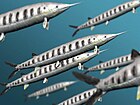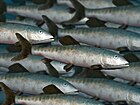Oreochima
| Oreochima | |
|---|---|
| Scientific classification | |
| Domain: | Eukaryota |
| Kingdom: | Animalia |
| Phylum: | Chordata |
| Class: | Actinopterygii |
| Family: | †Archaeomaenidae |
| Genus: | †Oreochima Schaeffer & Elliot, 1972 |
| Species: | †O. ellioti
|
| Binomial name | |
| †Oreochima ellioti Schaeffer & Elliot, 1972
| |
Oreochima is an archaeomaenid ray-finned fish from Lower Jurassic-aged freshwater strata of Queen Alexandra Range, Antarctica. Fossils come from the Lower Jurassic Mawson Formation (Toarcian) of Storm Peak, Antarctica, where a freshwater lake system, called "Lake Carapace", once existed.[2] O. ellioti is also notable for being one of few archaeomaenid genera found outside of Australia, as well for be one of the oldest members of the family.[2][3]
Description[edit]
Two nearly complete specimens of Oreochima ellioti (specimens AMNH 9910 and AMNH 9916) have an average total length of about 60 mm, with incomplete specimens represent individuals of similar size.[2] The frontals taper anteriorly and were slightly notched where they were in contact with the nasals. The opercular bone was about twice as high as the subopercular.[2]
Phylogeny[edit]
The cladogram below is simplified after a phylogenetic analysis by Bean (2021). Archaeomaenidae was recovered as one of the most basal stem-teleost clades, lying crownward of the families Pachycormidae and Aspidorhynchidae, but stemward of the family Pholidophoridae:[3]
Paleoenvironment[edit]
The Mawson Formation represents the fossiliferous interbeds of the Kirkpatrick Basalt, part of the Ferrar Group volcanic events, with age constraint in between 180+/-3.5 Ma-176.6+/-1.8 Ma, well correlated with the evolution of the Ferrar Large Igneous Province during the initial breakup of Gondwana.[3] This layers record sedimentary and biotic processes in relatively shallow lakes and ponds, and in surrounding wetlands to upland areas, with the biota of the lakes having access to magmatic sources. The so called "Lake Carapace", the main water body recovered locally, was, like the "Chacritas Paleolake" of the sister Cañadón Asfalto Formation in Patagonia, developed following the local rift in a similar way to the modern Lake Magadi in the Kenyan Rift Valley, as proven by the discovery of Chert like the one found in this African lake, that suggests both, Carapace and Chacritas were likely alkaline lakes that had inflows of hydrothermal fluids.[4] Hydrothermal activity help the development of microbes (Archaea) and helping the fauna on cooler events. Alongside Oreochima lived the spinicaudatan Carapacestheria disgregaris, notostracan branchiopods, ostracoda, up to 50 specimens of insect nymphs and wings (mayflies, the dragonfly Caraphlebia antartica, and a Coleopteran).[5][6] and plant leaves (Zamites).[7][8]
See also[edit]
References[edit]
- ^ Heimann, A.; Fleming, T. H.; Elliot, D. H.; Foland, K. A. (1994). "A short interval of Jurassic continental flood basalt volcanism in Antarctica as demonstrated by 40Ar39Ar geochronology". Earth and Planetary Science Letters. 121 (1–2): 19–41. Bibcode:1994E&PSL.121...19H. doi:10.1016/0012-821X(94)90029-9. Retrieved 26 July 2022.
- ^ a b c d Schaeffer, Bobb (1972). "A Jurassic Fish from Antarctica". American Museum of Natural History. 2495 (2): 1–18. hdl:2246/2702. Retrieved 26 July 2022.
- ^ a b c Bean, L. B. (2021). "Revision of the Mesozoic freshwater fish clade Archaeomaenidae". Alcheringa: An Australasian Journal of Palaeontology. 45 (2): 217–259. doi:10.1080/03115518.2021.1937700. S2CID 237518065.
- ^ Hieger, T. J.; Serbet, R.; Harper, C. J.; Taylor, E. L.; Taylor, T. N.; Gulbranson, E. L. (2015). "Cheirolepidiaceous diversity: An anatomically preserved pollen cone from the Lower Jurassic of southern Victoria Land, Antarctica". Review of Palaeobotany and Palynology. 220 (3): 78–87. Bibcode:2015RPaPa.220...78H. doi:10.1016/j.revpalbo.2015.05.003. hdl:2262/96280. Retrieved 8 March 2022.
- ^ Carpenter, F. M. (1969). "Fossil insects from Antarctica". Harvard University. 76 (3): 418–425. Retrieved 8 March 2022.
- ^ Tasch, P. (1973). "Jurassic beetle from southern Victoria Land, Antarctica". Journal of Paleontology. 47 (2): 590–592. Retrieved 8 March 2022.
- ^ Babcock, LE; Leslie, SA; Elliot, DH; Stigall, AL (2006). "The "Preservation Paradox": microbes as a key to exceptional fossil preservation in the Kirkpatrick Basalt (Jurassic), Antarctica" (PDF). The Sedimentary Record. 4 (2): 4–8. doi:10.2110/sedred.2006.4.4. Retrieved 7 March 2022.
- ^ Stigall, A. L.; Babcock, L. E.; Briggs, D. E. G.; Leslie, S. A. (2008). "Taphonomy of Lacustrine Interbeds in the Kirkpatrick Basalt (Jurassic), Antarctica". PALAIOS. 23 (6): 344–355. Bibcode:2008Palai..23..344S. doi:10.2110/palo.2007.p07-029r. JSTOR 27670515. S2CID 128700143. Retrieved 7 March 2022.
External links[edit]
- "Pachycormiformes". Paleobiology Database. Retrieved November 11, 2012.







